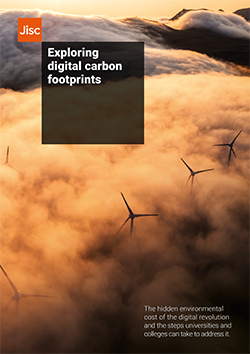Exploring digital carbon footprints
The hidden environmental cost of the digital revolution and the steps universities and colleges can take to address it.

How can the education sector shape its sustainable future? There has, arguably, never been a more important or urgent question for all of us in education to address.
About the report
The carbon impact of digital technologies is huge and growing at an exponential rate, which has been accelerated further by the rapid digitalisation forced by the COVID-19 pandemic.
Digital is now more entwined in our lives than ever, yet it is easy to underestimate the extent of the environmental harm it can cause.
Organisations of all types, education included, are discovering that the greatest contributors to their carbon footprints are the services and products they buy. Indeed, a vast majority (approximately 80%) of IT’s carbon footprint can be attributed to the manufacturing and distribution of the equipment itself. The rest comes from operational usage.
IT is often one of the biggest contributors to an education institution’s own carbon footprint, with one UK college attributing 20% of its emissions to IT alone.
How we source, procure and dispose of our technology assets is the first area to address, an important part of this being how to use equipment for longer.
Increasingly, technology companies are providing solutions to these challenges by improving carbon transparency in the supply chain, or helping lower the barriers to extended technology life through refurbished, remanufactured and re-homed tech.
Operational digital carbon emissions apply to on-premises, cloud and remote technology use. Within these areas there are opportunities for increasing awareness, measuring, communicating and improving impact.
The key to improving our digital carbon footprint is in taking informed action, which requires understanding and awareness. College and university leaders can use technologies such as carbon calculator apps and real-time energy consumption carbon emission dashboards to measure and communicate impact.
Four key topic areas
The report focuses on highlighting the source and impact of digital carbon footprints for:
- Procurement
- On-premises IT
- Cloud technologies
- Remote working
Read the full report
pdf, 5.9 MB, 60 pages
About the author
